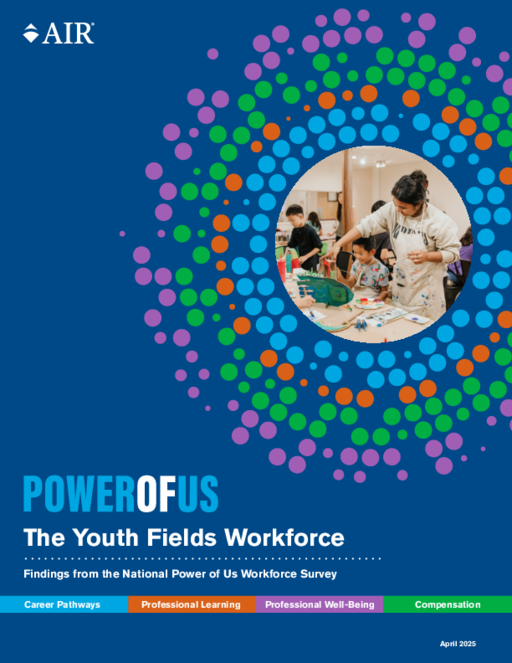Research Approach
More
Less
- Author(s)
- Deborah Moroney, Megan E.M. Brown, Anne E. Diffenderffer, Deepa S. Vasudevan, Jill Y. Richter, Rachel Carroll, Amy K. Syvertsen, and Gislene N. Tasayco Prado
- Publisher(s)
- American Institutes for Research
Research Approach
The AIR team developed the Power of Us Workforce Survey in collaboration with a technical working group of youth-fields experts, who helped identify key topics of interest about the workforce and supported developing survey questions and content.
To recruit survey respondents, AIR engaged Collaborative Communications Group. Collaborative Communications led a comprehensive 18-month communications campaign to reach the youth-fields workforce. The campaign included conference presentations, social media outreach, a dedicated website, and peer-to-peer encouragement supported by hundreds of youth fields organizations. To ensure that the survey also reached members of the workforce who may not be connected to this professional community, the AIR team sampled 190 counties in the United States that together represent the population of the country based on state, urbanicity, and adult population size. The final set of counties included three to four counties in each U.S. state. The team then conducted email, phone, and mail outreach to youth-serving organizations in these counties to encourage participation.
The survey collected data from across multiple states, regions, organization types and levels, and sector(s) of the youth field.
In total, the survey, which was fielded from February 22, 2022, to March 31, 2023, was completed by over 10,000 current and former adult workers in the youth field, data. The respondents gave insights on career pathways, professional learning needs, compensation, and well-being. This report reflects the responses from the more than 7,000 respondents who were in paid positions in the workforce at the time of the survey.
Because there is no existing baseline data on this workforce, it was not possible to determine to what extent this sample represents the workforce. However, this report is considered a valid baseline of youth fields staff and their experiences. The report uplifts three considerations to keep in mind when reviewing the survey findings related to the characteristics of respondents within this sample.
- The “Leadership Effect.” There is high representation of respondents in leadership positions in the survey data. Therefore, findings for the overall sample will be more influenced by the experiences of those in a leadership role compared to experiences of those not in a leadership role.
- The “Generation Z Effect.” Compared with older respondents, respondents ages 18–25 are more likely to be BIPOC (particularly Latinx), part-time staff, and not in a leadership position. Therefore, it is possible that differences between respondents in leadership positions compared to respondents not in leadership positions may be driven by the demographic characteristics of age, race, and/or part-time status.
- The “California Effect.” Latinx respondents and respondents ages 18–25 were more likely to work in California, which may influence the findings for younger and Latinx respondents overall.

